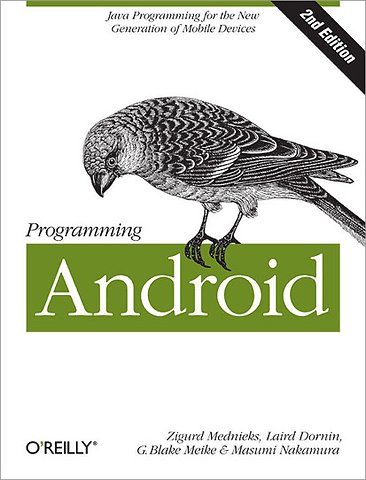


Zigurd Mednieks is Chief User Interface Architect at D2 Technologies, a leading provider of IP communications technology, and is a consultant and advisor to companies in the field of embedded user interfaces.
Meer over de auteursProgramming Android
Java Programming for the New Generation of Mobile Devices
Paperback Engels 2012 2e druk 9781449316648Samenvatting
Get thoroughly up to speed on Android programming, and learn how to create up-to-date user experiences for both handsets and tablets. With this book's extensively revised second edition, you'll focus on Android tools and programming essentials, including best practices for using Android 4 APIs. If you're experienced with Java or Objective-C, you'll gain the knowledge necessary for building well-engineered applications.
'Programming Android' is organized into four parts:
- Part One helps programmers with some Java or iOS experience get off to a fast start with the Android SDK and Android programming basics.
- Part Two delves into the Android framework, focusing on user interface and graphics class hierarchies, concurrency, and databases. It's a solid foundation for understanding of how the most important parts of an Android application work.
- Part Three features code skeletons and patterns for accelerating the development of apps that use web data and Android 4 user interface conventions and APIs.
- Part Four delivers practical coverage of Android's multimedia, search, location, sensor, and account APIs, plus the Native Development Kit, enabling developers to add advanced capabilities.
This updated edition of 'Programming Android' focuses on the knowledge and developer priorities that are essential for successful Android development projects.
Specificaties
Lezersrecensies
Over Blake Meike
Inhoudsopgave
Part 1: Tools and Basics
1. Installing the Android SDK and Prerequisites
-Installing the Android SDK and Prerequisites
-Test Drive: Confirm That Your Installation Works
-Components of the SDK
-Keeping Up-to-Date
-Example Code
-On Reading Code
2. Java for Android
-Android Is Reshaping Client-Side Java
-The Java Type System
-Scope
-Idioms of Java Programming
3. The Ingredients of an Android Application
-Traditional Programming Models Compared to Android
-Activities, Intents, and Tasks
-Other Android Components
-Component Life Cycles
-Static Application Resources and Context
-The Android Application Runtime Environment
-Extending Android
-Concurrency in Android
-Serialization
4. Getting Your Application into Users' Hands
-Application Signing
-Placing an Application for Distribution in the Android Market
-Alternative Distribution
-Google Maps API Keys
-Specifying API-Level Compatibility
-Compatibility with Many Kinds of Screens
5. Eclipse for Android Software Development
-Eclipse Concepts and Terminology
-Eclipse Views and Perspectives
-Java Coding in Eclipse
-Eclipse and Android
-Preventing Bugs and Keeping Your Code Clean
-Eclipse Idiosyncrasies and Alternatives
Part 2: About the Android Framework
6. Building a View
-Android GUI Architecture
-Assembling a Graphical Interface
-Wiring Up the Controller
-The Menu and the Action Bar
-View Debugging and Optimization
7. Fragments and Multiplatform Support
-Creating a Fragment
-Fragment Life Cycle
-The Fragment Manager
-Fragment Transactions
-The Support Package
-Fragments and Layout
8. Drawing 2D and 3D Graphics
-Rolling Your Own Widgets
-Bling
9. Handling and Persisting Data
-Relational Database Overview
-SQLite
-The SQL Language
-SQL and the Database-Centric Data Model for Android Applications
-The Android Database Classes
-Database Design for Android Applications
-Using the Database API: MJAndroid
Part 3: A Skeleton Application for Android
10. A Framework for a Well-Behaved Application
-Visualizing Life Cycles
-Visualizing the Fragment Life Cycle
-The Activity Class and Well-Behaved Applications
-Life Cycle Methods of the Application Class
11. Building a User Interface
-Top-Level Design
-Visual Editing of User Interfaces
-Starting with a Blank Slate
-Laying Out the Fragments
-Folding and Unfolding a Scalable UI
-Making Activity, Fragment, Action Bar, and Multiple Layouts Work Together
-The Other Activity
12. Using Content Providers
-Understanding Content Providers
-Defining a Provider Public API
-Writing and Integrating a Content Provider
-File Management and Binary Data
-Android MVC and Content Observation
-A Complete Content Provider: The SimpleFinchVideoContentProvider Code
-Declaring Your Content Provider
13. A Content Provider as a Facade for a RESTful Web Service
-Developing RESTful Android Applications
-A "Network MVC"
-Summary of Benefits
-Code Example: Dynamically Listing and Caching YouTube Video Content
-Structure of the Source Code for the Finch YouTube Video Example
-Stepping Through the Search Application
-Step 1: Our UI Collects User Input
-Step 2: Our Controller Listens for Events
-Step 3: The Controller Queries the Content Provider with a managedQuery on the Content Provider/Model
-Step 4: Implementing the RESTful Request
Part 4: Advanced Topics
14. Search
-Search Interface
-Query Suggestions
15. Location and Mapping
-Location-Based Services
-Mapping
-The Google Maps Activity
-The MapView and MapActivity
-Working with MapViews
-MapView and MyLocationOverlay Initialization
-Pausing and Resuming a MapActivity
-Controlling the Map with Menu Buttons
-Controlling the Map with the Keypad
-Location Without Maps
-StreetView
16. Multimedia
-Audio and Video
-Playing Audio and Video
-Recording Audio and Video
-Stored Media Content
17. Sensors, NFC, Speech, Gestures, and Accessibility
-Sensors
-Near Field Communication (NFC)
-Gesture Input
-Accessibility
18. Communication, Identity, Sync, and Social Media
-Account Contacts
-Authentication and Synchronization
-Bluetooth
19. The Android Native Development Kit (NDK)
-Native Methods and JNI Calls
-The Android NDK
-Native Libraries and Headers Provided by the NDK
-Building Your Own Custom Library Modules
-Native Activities
Index
Anderen die dit boek kochten, kochten ook
Rubrieken
- advisering
- algemeen management
- coaching en trainen
- communicatie en media
- economie
- financieel management
- inkoop en logistiek
- internet en social media
- it-management / ict
- juridisch
- leiderschap
- marketing
- mens en maatschappij
- non-profit
- ondernemen
- organisatiekunde
- personal finance
- personeelsmanagement
- persoonlijke effectiviteit
- projectmanagement
- psychologie
- reclame en verkoop
- strategisch management
- verandermanagement
- werk en loopbaan





